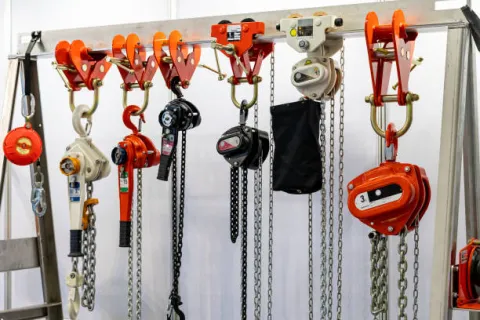Chain Block: Don't Confuse It with Lever Block!
If you're looking for a simple lifting tool, a chain block might be the answer. However, don't confuse it with a lever block. While both are simple lifting tools that use pulleys, gears, chains, and hooks, there are significant differences.
Let's Get to Know What a Chain Block Is
Before diving into the differences between chain blocks and lever blocks, it's good to get familiar with what a chain block is.
A chain block, often referred to as a pulley, is a relatively small tool used for various lifting tasks. The lifting capacity of chain blocks ranges from 0.5 tons to 50 tons, and they are typically used for low-height lifting.
So, what exactly is a chain block? As mentioned above, a chain block is a manually operated tool that uses pulleys, chains, gears, and hooks to lift loads.
This tool is usually suspended using additional equipment such as a plain trolley attached to an H-Beam, and it is used to slowly lift and lower items.
Now, do you understand what a chain block is?
After understanding chain blocks, you surely don't want to confuse them with lever blocks anymore. Fundamentally, there are several differences between chain blocks and lever blocks:
Difference in Operation
Although both use pulleys, gears, and chains, there is a fundamental difference in how they operate.
Smaller gears are responsible for turning larger gears. We are responsible for turning the smaller gears, while the larger gears handle lifting and lowering the load.
So, what's the difference? It's in the operation position. Chain blocks can only be used for vertical lifting, while lever blocks can be used for both vertical lifting and horizontal pulling.
Difference in Usage
Besides their operation, chain blocks and lever blocks differ in usage. Chain blocks are commonly used for short or long lifting needs because they are easy to use by simply pulling by hand. The downside is that the lifting/pulling speed depends on the force we exert.
What about lever blocks? They can generally be used for lifting, pulling, and binding. However, because the lifting and pulling are done using chains, the process takes longer.
Moreover, lever blocks are limited in their lever rotation. This can slow down the work if used for long lifting needs.
Advantages and Disadvantages of Chain Blocks
After understanding the differences between chain blocks and lever blocks, it's also essential to know the advantages and disadvantages of chain blocks commonly used in the field. Here are some advantages:
- Chain blocks do not require electricity, so they can be used anytime and anywhere.
- The chain on a chain block can be replaced if damaged, making it easy to maintain.
- They can be used in conjunction with hoists and cranes.
- The lifting speed can be adjusted according to the pulling speed.
These four points highlight the advantages of a chain block. What about the disadvantages? Here are some disadvantages of chain blocks that should be known before purchasing:
- Chain blocks cannot lift loads in a hurry, so they can only lift at a standard speed.
- They cannot be used for binding and pulling items.
- They can only be used for vertical lifting.
- If the chain is pulled carelessly, it can get tangled or twisted.
Now you know that even though both use pulleys, chains, and gears, chain blocks are different from lever blocks. So, make sure not to confuse them before making a purchase.
For further consultation about SpanSet Indonesia products and services, please contact us via email at sales@spanset.co.id or WhatsApp
To find specification detail and prices of SpanSet Indonesia Products, please visit SpanSet Indonesia Marketplace on Tokopedia and Shopee.
